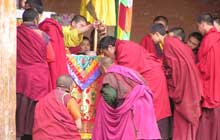
 Shangri-La – is there another word so redolent of a utopia on the roof of the world? Since the publication of James Hilton's novel "Lost Horizon" in the 1930s, the western imagination has been gripped by the promise of an earthly paradise somewhere high in the Himalayas . Hilton had travelled in the region a few years before his novel was published, but never gave the exact location, and to this day it remains a mystery. (In a telling mirror image, Chinese culture has long been obsessed with a paradise somewhere to the West, near the Kunlun Mountains which run to the south of the Taklamakan Desert .) One of the present-day contenders for hosting this utopia was known in Chinese as Zhongdian County until 2002 when it officially changed its name to Shangri-La County . Its Tibetan name remains Gyalthang. Is this the real Shangri-La? You can form your own opinion, but it certainly has some of the necessary attributes. High up in the mountains at an altitude of over 10,000 feet, it is home to the Ganden Sumtseling Monastery in whose valley lie old Tibetan villages hinting at a pastoral utopia.
Shangri-La – is there another word so redolent of a utopia on the roof of the world? Since the publication of James Hilton's novel "Lost Horizon" in the 1930s, the western imagination has been gripped by the promise of an earthly paradise somewhere high in the Himalayas . Hilton had travelled in the region a few years before his novel was published, but never gave the exact location, and to this day it remains a mystery. (In a telling mirror image, Chinese culture has long been obsessed with a paradise somewhere to the West, near the Kunlun Mountains which run to the south of the Taklamakan Desert .) One of the present-day contenders for hosting this utopia was known in Chinese as Zhongdian County until 2002 when it officially changed its name to Shangri-La County . Its Tibetan name remains Gyalthang. Is this the real Shangri-La? You can form your own opinion, but it certainly has some of the necessary attributes. High up in the mountains at an altitude of over 10,000 feet, it is home to the Ganden Sumtseling Monastery in whose valley lie old Tibetan villages hinting at a pastoral utopia.
This modern-day Shangri-La did not begin life as a utopia, but was an important stop on the Tea and Horse Route that ran from Yunnan up into Tibet . South the path went down to Lijiang and the lower tea lands of Yunnan, while to the north the path skirted the magnificent Kawa Karpo Mountain, with its peak at over 20,000 feet, before heading into Tibet proper. Even today this route has been acknowledged as the best path from Yunnan into Tibet with the Chinese-made 'highway' running the path. Gyalthang, as the Tibetans call it, occupies a special position in Tibetan history. Its famous monastery (see below) was built at the behest of the Fifth Dalai Lama, and the town was where many of the eastern Tibetans or Kham would congregate and compete in horse skills and other contests. The town sits in one of the final valleys before the massive mountains stretch off to Tibet and western Sichuan . Through the tight valleys come three massive rivers, the Yangtse, the Mekong and the Salween , which between them flow to the sea as far apart as the coastlines of Burma and Shanghai . With those rivers also comes a variety of animal life, and the area is duly famed for the migrating birds that enrich the environment. Early summer also sees a profusion of alpine flowers decorating the valleys and mountains.
Having remained much on the margins of Chinese history, the turbulent 1930s saw the Communist armies come through the area on their Long March. The same armies returned some two decades later to make sure that the area was 'liberated' and that it would become wholly answerable to Beijing . Two theoretical utopias collided and for a time the Chinese Marxist version had the upper hand. The Cultural Revolution, from 1966-76, was mostly a dreadful experience for the ethnic minorities under Chinese rule. However, once the Maoist Socialist heaven ran its course, the possibility for individual business heavens became possible again, and the locals, in the town then known as Zhongdian, took well to this. In the late 1990s the local Tibetan farmers discovered that one of the many types of mushroom that flourished in their Eden, which they only rarely picked for themselves, was a fervently sought after fungus in Japan where the top quality local variety could fetch close to a thousand dollars per pound. For a few years it was estimated that more than half, and at times up to three-quarters, of the residents of this heaven were involved in one way or another in getting those mushrooms from the base of the pine trees to the plates of Japanese connoisseurs within a couple of days.
It is not only Westerners and Japanese who have been transfixed by the promises of this ideal world and what may be found there, the Chinese have long had a tradition that looked to this part of the world as the gateway to some form of eternal paradise. For the Chinese, these lands and mountains were the location of some of their earliest records of shamanistic spirit travel. It was home to the Western Paradise of Buddhism, and somewhere to the West lay the fabled Kunlun Mountains , where the Chinese immortals were reputed to live. To this very day, from spring on, when the snows begin to melt and the wild mountain herbs begin to grow the Tibetans can be seen on the streets of every major Chinese city, offering those herbs, with their promise of good health to those tempted by the dream of Shangri-La.